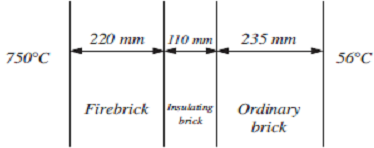Reference no: EM13691766
Question 1. (a) A small reheating furnace wall consists of 200 mm of firebrick. The inner surface of the wall is at a temperature of 320 °C and the outside temperature is 35 °C. Calculate the rate at which heat is transferred, by conduction, through unit area of the wall. The thermal conductivity of the firebrick used can be taken as 1.8 W m-1 K-1.
If the outside surface area of the furnace is 50 m2 estimate the heat losses through the furnace wall per hour.
(b) A furnace wall consists of three layers of material as shown below.

The thermal conductivities are:
firebrick = 1.15 W m-1 K-1
insulating brick = 0.17 W m-1 K-1
ordinary brick = 0.62 W in-1 K-1
Calculate:
(i) the thermal resistance of each layer
(ii) the heat loss per unit area
(iii) the temperature at the two interfaces.
Question 2. A surface condenser consists of a bank of horizontal tubes contained within a steel shell. Saturated steam is condensed on the outside of the water-cooled tubes and the condensate drains to the bottom of the shell where it collects and is pumped out. Tubes towards the bottom of the tube bank are drenched by the water draining from above, and the average thickness y (metres) of the laminar water film flowing over a tube is given by the equation
y = 1.39 (μΤ/ρ28)
where Τ is the mass flowrate of water falling onto unit length of tube, and the other symbols have their usual meanings.
Since the water falling onto the top of the tube divides and flows down both sides, the average Reynolds number is given by
Re = 2Τ/μ
Assuming that local condensation does not significantly increase the film thickness on the drenched tubes, use the following data to find the heat flux and condensation rate per unit area for one particular tube.
Question 3. A pipe of outside diameter 200 mm is lagged with an insulating material of thermal conductivity 0.06 W K-' and thickness 75 mm. The pipe carries a process fluid at a temperature of 300 °C and the average temperature of the outer surface of the lagging is 45 °C.
(a) Estimate the rate of heat loss per metre length of pipe.
(b) Explain why the thermal resistance of the pipe wall can be ignored.
Question 4. A pipe carrying superheated steam at 300 °C has an outside diameter of 120 mm and is lagged with two layers of insulating material. The first layer (adjacent to the outer pipe wall) is 25 mm thick and has a thermal conductivity of 0.072 W m-3 K-'. The second layer (covering the first layer) is 20 mm thick, has a thermal conductivity of 0.051 W 1C-1 and an outside temperature of 28 °C.
Estimate the rate of heat loss per metre length of pipe (assume the thermal resistance of the pipe wall is negligible).